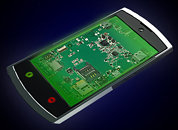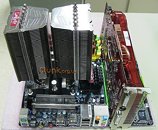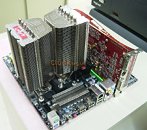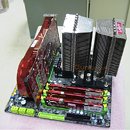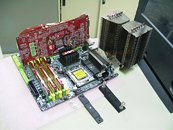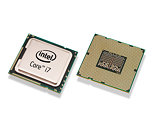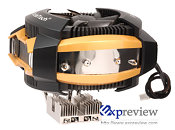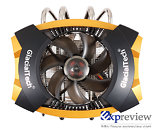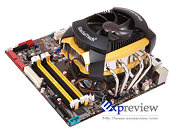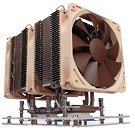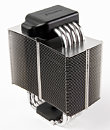Clunk.org.uk have got hold of some photos of what appears to be a DFI LanParty branded CPU Cooler. The design is something new, featuring 6 heatpipes, effectively acting as 12 and with two independant heatsinks. No details such as pricing or availability accompany the images, but it is believed DFI are in collaboration with Thermalright and as such this could be a joint venture between them. The cooler seems to be held on with a prototype bolt on kit, which one would expect to change before the product reaches retail.

According to VRZone, Intel is planning to launch the next generation of Atom CPU's in Q4 2009 with a 45nm single core version, codenamed Pineview, a dual core CPU will shortly follow in Q1 2010. It seems Intel are gearing up to a single chip solution and with this particular generation of Atom, the CPU will be joined by the IGP and memory controller and is based on Lincroft Architecture. There also appears to be a new southbridge in the works to accompany this new chip. No longer do we have ICH-XX variants, but instead this new piece of silicon has been called Tiger Point. Between the two the platform will be known as the Pine Trail-D and will support memory speeds of upto 800Mhz DDR2. Intel claims there will be a 70% reduction in total kit package size and a 50% reduction in total kit TDP.

The the coming months, AMD is planning to launch a series of quad-core and triple-core processors to strengthen the company's hold on the sub-$200, even sub-$150 market segment. Intel is reportedly planning a rival lineup of quad-core processors to counter AMD in the segmet. While the Core 2 Quad Q8000 series from Intel makes for its current low-end quad-core CPU lineup, the new lineup will be categorized under the Q7000 series.
Characteristics of the Q7000 series include a total L2 cache size of 2 MB (1 + 1 MB), which is half of that of the Q8000 and a sixth of that of the Q9000 series. The processors will use a narrower 800 MHz FSB and will be built on the 45nm manufacturing process. They will come with rated TDPs of 65W. The first model in this series will be the Core 2 Quad Q7500, which comes with a clock speed of 2.60 GHz. The chip will be priced under US $150, straying into AMD's budget quad-core chip territory.

Intel Corporation introduced its most advanced desktop processor ever, the Intel Core i7 processor. The Core i7 processor is the first member of a new family of Nehalem processor designs and is the most sophisticated ever built, with new technologies that boost performance on demand and maximize data throughput. The Core i7 processor speeds video editing, immersive games and other popular Internet and computer activities by up to 40 percent without increasing power consumption.
Broadly heralded by the computing industry as a technical marvel, the Intel Core i7 processor holds a new world record of 117 for the SPECint_base_rate2006 benchmark test that measures the performance of a processor. This is the first time ever for any single processor to exceed a score of 100 points.

Believe it or not, although the Core i7 processors have just became available, Intel won't be giving up on its LGA 775 product line-up. According to the trustworthy reporters at DailyTech, on January 18, Intel will launch three new Core 2 Quad processors with a TDP of just 65W. These will be the Intel Core 2 Quad Q8200s (2.33GHz, 4MB L2 cache, FSB 1333MHz), Q9400s (2.66GHz, 6MB L2 cache, FSB 1333MHz), and Q9550s (2.83GHz, 12MB L2 cache, FSB 1333MHz) models, priced at $245, $320 and $369 respectively. All three models differ from their brothers from the s-letter in their nomenclature. Intel will also launch a new 2.6GHz Pentium Dual Core E5300 processor in November of this year and one more, the 2.7GHz Pentium Dual Core E5400 on January 18th next year. The second CPU will be priced at $84 when available. Lastly, Intel's power efficient 35W processor lineup will also see some changes at the end of the year. The new T9800 (2.70GHz, 6MB L2 cache, FSB 1066MHz, $530), Q9000 (2.00GHz, 6MB L2 cache, FSB 1066MHz, $348), P9600 (2.66GHz, 6MB L2 cache, FSB 1066MHz, $348), T9550 (2.66GHz, 6MB L2 cache, 1066MHz, $316), and P9600 (2.53GHz, 3MB L2 cache, FSB 1066MHz, $241) will be released then.
Glacialtech, one of Intel's stock-cooler suppliers, has taken a step into the branded high-end cooling segment with its UFO CPU cooler. Expreview took a few snaps of the cooler, which shows a large fin array suspended on four heatpipes, on which two 38 CFM, 92 mm fans blow air downward. The two fans sandwich the aluminum fins, and are covered by sporty black and yellow shrouds. The combined noise of the fans is rated at 28 dBA (at max. speed of 2000 rpm). The cooler supports all current CPU sockets, and is expected to release soon.
Whichever way the global economy is headed, 3Q, 2008 hasn't been a bad period for computer hardware industry. The GPU market saw its bumper sale in six years, with both NVIDIA and AMD reaping inflows. Similar trends were also reported with other sections of the industry. The CPU for one, is commodity closely linked to the growth of the industry. 3Q 2008 saw record earnings for Intel as well, as the silicon giant continued its market-share gains into rival AMD, as recorded by market observer iSuppli.
According to iSuppli figures held by Information Week, Intel now holds a massive 80.4% of the CPU market share, which is up 1.7% from Q3 2007. AMD's share on the other hand fell 1.8 percentage points to 12.1% from 13.9% a year ago. Compared to Q2 2008, AMD's market share grew by 0.1%, and Intel's grew by 0.3%. There is a clear influence of smaller CPU vendors that has affected AMD's share. These smaller vendors are finding it increasingly difficult to compete on a global scale amidst the economic crisis.
Denmark's Danamics LM10 CPU cooler, the world's first commercially available liquid metal-based processor cooler, was reported today to have received a release date. The LM10 will land in Europe as of November 17th, but it will come in limited quantities. Outside of Europe, Danamics is still awaiting approval of its liquid metal-based technology, and after one is obtained the company can start selling.
Recently, Danamics engineers claimed to have developed a CPU cooler that will put to shame every air cooling solution available and most of the current water cooling kits. The LM10 has no moving parts and an unlimited mean time between failures. Inside is a yet-to-be-named liquid metal that's said to provide superior thermo physical properties and is circulated without moving parts thanks to a built-in electromagnetic pump. Expect more information next week.

During IDF Taipei earlier last week Intel demonstrated its DCC (Desktop Control Center) overclock software for the forthcoming Intel Core i7 processors. The DCC is a easy to work with software that will allow overclocking in Windows environment and help novice overclockers and experts. The Desktop Control Center can adjust CPU multiplier, voltage, memory timings and clock speed as well as various system voltage options such as the QPI voltage. The DCC also gives you the option to switch on and off Turbo Boost in Windows, and monitor system temperature readings.

Today, AMD is announcing two new processors to its products line - AMD Phenom X3 8850 Black Edition and AMD Athlon X2 5050e. The Socket AM2+ triple core X3 8850 (TRAY OPN# HD8850WCJ3BGH) works at 2.5GHz, has a TDP of 95W and 2MB of L3 cache. The Phenom X3 8850 is the first triple-core Phenom processor to be part of the company's Black Edition series and as such it has unlocked multiplier for overclocking. The AMD Athlon X2 5050e (TRAY OPN# ADH5050IAA5DO) is a dual-core 45W processor that operates at 2600MHz.
Sooner or later AMD is also expected to commence shipments of two low-power chips - the single-core 1.6GHz Athlon 2650 (TDP 15W), and the dual-core Athlon X2 3250e, running at 1.5GHz and requiring up to 22W. November will also see AMD's "Ultra-Value Client (UVC) Solutions", the chips that will possibly compete with Intel Atom CPUs for netbooks. These are only for the OEM customers, though.

Intel Clarksfield, the company's Nehalem based mobile platform, was reported on Monday to begin production in the second half of 2009. Although mass production of the first Core i7 processors is scheduled for next month, on the mobile front Intel users will have to wait until late next year. Clarksfield will be produced using the same 45-nanometer production process that's used to make Intel's current chip lineup. The upcoming chip will be the heart of a new Intel Centrino platform, codenamed Calpella. As its desktop variant, Clarksfield CPUs will have all the enhancements Nehalem offers, as well as the brand new integrated memory controller all in one package. Clarksfield is also expected to include more advanced power-management features than Intel's current mobile chips.

Noctua today released four new CPU coolers for Intel Xeon and AMD Opteron processors. Optimized for use in dual socket systems, the new DX (Dual Xeon) and DO (Dual Opteron) versions of Noctua's highly successful NH-U12 and NH-U9 series introduce the premium quality quiet cooling performance that has become synonymous with Noctua to the world of professional workstations and servers. "Maximum cooling performance at minimum noise levels and excellent reliability can be particularly important when it comes to high-end workstations and special server applications", explains Mag. Roland Mossig, Noctua CEO. "Due to the ever-growing demand for our Xeon and Socket F mounting kits, we decided to design new, customized versions of our coolers that are completely tailor-made for use on Intel Xeon and AMD Opteron systems, especially dual socket configurations. Enter the DX/DO series!"

Intel has updated its plans with the desktop CPU lineup across segments with some of the current products getting discontinued from manufacturing. The company will send product discontinuance notices (PDNs), documents sent to relevant firms in the industry, notifying them of a time-frame in which the company plans to stop production of a product. Some products are also slated to reach end of life (EOL). Along with this, there are also plans to bring in new products based on the current architecture.
Sources at motherboard vendors tell that by Q1 2009, the Core 2 Extreme QX9770 and QX9650 discontinue, with PDNs being issued. They will be totally phased-out by Q2. The company will also send out PDNs for four quad-core CPUs including the Core 2 Quad Q9450, ten dual-core CPUs including the Core 2 Duo E8300, three Pentium CPUs including the Pentium E2220 and the Celeron E1200 starting in November, and all products will phase out between the first and second quarters next year. Other highlights include:

DigiTimes made today the early announcement of two low-power AMD desktop processors that are to appear sometime in November. The Athlon 2650E and Athlon X2 3250E will both be part of the company's UVC (Ultra-Value Client) product line targeting OEMs. The single core 2650E CPU will have a core frequency of 1.6GHz and TDP of 15W, while the dual-core Athlon X2 3250e will have a core frequency of 1.5GHz and TDP of 22W. The two CPUs will be fabbed on a 65nm process and will initially be provided to OEM customers only. Manufacturers like ASUSTeK Computer, Acer and Shuttle, are expected to show up machines powered by the two processors in December. In additional news, AMD is also planning to launch a triple-core Phenom X3 8850 CPU using a 65nm process in early October. The CPU will feature a core frequency of 2.5GHz and a maximum TDP of 95W. The company will also launch a new Black Edition CPU in December.
Chinese researchers unveiled details of a general-purpose microprocessor with which they hope to give computing to the most ordinary people in China. The chip, code-named "Godson-3", was developed with government funding by more than 200 researchers at the Chinese Academy of Sciences' Institute of Computing Technology (ICT). Analysts suggest this takes China one step closer technological independence.
These chips are being manufactured by ST Microelectronics and branded as "Loongson" meaning Dragon Chip. Predecessors of this chip have been manufactured since 2001 and with its advancement marks rapid propagation of the Linux platform and other open-source software. These PCs would make it to as many workplaces and schools as the Chinese government can take them to. It is noted that the Godson-3 that has four processing cores releases in 2009 with a design that is scalable. In fact an 8-core version is planned as well. These chips use the 65nm fabrication process, with the 4-core version rated to consume as low as 10W. An interesting bit on the machine architecture is that these chips aren't x86 per say, but the designers have added instruction sets to simulate an x86-like environment. With it they hope to run a broader range of software, Microsoft Windows included. Since its a simulated x86 environment, a license from Intel isn't required. Erik Metzger, a patent attorney at Intel, says that the chip will only perform at about 80% of the speed of an actual x86 chip.

Without doubt, AMD needs something revolutionary to pull it out of the mess it set itself in. AMD's first reaction to the Conroe onslaught was to lower prices and build up a "Smarter Choice" repute, though with successive price cuts from Intel and down-scale products based on the Core architecture coming out by the fortnight, and the transit to 45nm fab process, there's been an increasing need for AMD to get back to the drawing boards with their CPU division.
From what looks like an excerpt from an AMD company slide, can be seen AMD's CPU plans for 2009. The chart broadly shows that K10 architecture is here to stay. Throughout the year, desktop CPUs based on the K10 architecture feature in the roadmap, with no signs of their "truly next-gen" architecture. AMD completes its transit to the 45nm silicon fabrication process and will finally embrace DDR3 system memory standards. To begin with, the fact that the Deneb core's entry slightly steps into the 2008 column shows that the Deneb core-based desktop CPU could release sometime towards the very end of this year. Sources note that two models based on the Deneb core could be out by the end of this year. It supports both DDR2 and DDR3 memory standards and socket compatible with current AM2+ and future AM3. From what's known so far, AM3 is the same 940 pin design that adds pins for the DDR3 memory interconnect between the CPU and the memory.

After Intel slashed the prices of several dual and quad core processors in the beginning of the week, today AMD informed it is tweaking the prices of three Phenom CPUs, too. First to receive price reduction is the 2.1GHz clocked triple core Phenom X3 8450, going down from $125 to $104. Second one is the 2.2GHz Phenom X4 9550 lowering down from $175 to $154. Third and final is the 2.6GHz X4 9850 Black Edition down from $205 to $194. All prices are for 1000-unit tray quantities.

Intel will release four mid-thru-high range desktop processors tomorrow. These CPUs will be based on the 45nm Yorkfield and Wolfdale cores. Two new Core 2 Quad models, the performance segment Q9650 and the mainstream segment Q9400 are dressed up. The Q9650 has identical parameters to the Core 2 Extreme QX9650 barring the locked FSB multiplier of 9x. The Q9400 is an improvement over the current Q9300. It has a 2.66 GHz core clock speed with a total of 6 MB L2 cache and an FSB multiplier of 8x.
With the Core 2 Duo, there is a top of the line dual core chip, the E8600 which comes with 3.33 GHz core speed, 6 MB of L2 cache and an FSB multiplier of 10x. There's also a mid-range offering, the E7300 that comes with 2.66 GHz core speed, 1066 MHz FSB and an FSB multiplier of 10x. It has 3 MB of L2 cache.

This is for all of you, who are impatiently waiting for that new CPU, the X58 boards with that new socket and that triple channel DDR3 support. Maximum PC has managed to get their hands on everything needed to build one of these systems. They give single, dual and triple channel memory setups a try as well. To top things off, they have even taken a few images. One image from Maximum PC can be seen below, but make sure to take a look at all the other ones on their site.

The newest fleet of quad-core desktop processors from AMD, the Deneb series is tested by Chinese website Zol to consume up to 12 per cent less power compared to equally clocked 65nm Agena parts, add to that, the fact that the 45nm Deneb comes with three times the amount of L3 cache, 6 MB.
The 45nm and 65nm parts were compared on a MSI K9A2 Platinum motherboard with a NVIDIA GeForce GTX 280 card, a single 320 GB HDD, two modules of 1GB DDR2 1066 MHz memory, the test-bed was powered by a Thermaltake Toughpower 1200W PSU. Power consumption was calculated in idle and load (the CPUs were stressed using instances of Orthos).

Following price-cuts for some of the desktop offerings (covered
here) , Intel has cut the prices of some models of the enterprise-segment Xeon processor, reports industry observer DigiTimes.
The Xeon X3220, X3210 and E3110 get a roughly 12% cut with the X3220 and X3210 both dropping from an original price of US $224 to US $198 with the E3110 price dropping from US $188 to US $167, according to the company.
Here's something new: A CPU cooler that comprises of a circulatory mechanism of liquid-metal, the liquid-metal has higher thermal conductivity than other liquid media, flowing liquid metal across an array of metal fins to disperse heat, and the cycle continues. What's more, the liquid is inextinguishable. That's 'cool'. Danamics innovated such a cooler for today's CPUs called the LM10.
The cooler also has no moving parts. The pump that circulates liquid-metal across tubes doesn't have them either. The pump functions on the principles of electromagnetic flow, the ferromagnetic liquid is subjected to flow caused due to changes in polarity of electromagnets. With no moving parts, the MTBF is substantially increased. Of course, you can use a retention module of some sort to hook up a fan or two on each side of the heatsink. This product will be available soon. For more information, please visit
this page.

One of the newest toys at Tom's Hardware is a Nehalem derivative Intel Bloomfield processor clocked at 2.93 GHz. This processor brings with it, a host of changes. To begin with, say goodbye to FSB. The processor communicates with the system using a technology called QuickPath interconnect. This is a high-speed, low-latency point to point link. It's comparable to the HyperTransport technology, which AMD has been using for close to five years now. Initially, Bloomfield will use a 20-bit wide 25.6 GB/sec. QuickPath link. The CPU incorporates the memory controller, which implies that your choice of memory will depend on the processor. As already noted in regard to the AMD processors, this approach of integrating a memory controller greatly reduces system-level latency. The CPU supports 3-channel DDR3 1333 MHz memory. That's 32 GB/s of bandwidth, with support for up to 24 GB of system memory. Of the six DDR3 slots, the first slot is required to be populated.
Unfortunately, Non-Disclosure Agreements (NDA) don't allow them to disclose performance evaluations at this point though - ironically - their Taiwanese team ran preliminary tests on a Radeon HD4850 and a Foxconn X58 motherboard we covered
here.
Read the whole article
here.

As of today, AMD is close to over a year and a half behind Intel with the implementation of the DDR3 system memory standard, and it doesn't look like we are going to see a DDR3 AMD platform only until late this year or early next year. Chilian website CHW.net published slides of the roadmaps for AMD chipsets in the months to come, also published are slides refering to the details of the next generation southbridge by AMD, even though the latest entry, the SB700 is only teething and only the latest motherboards with 7-Series chipsets feature this.

NVIDIA today unveiled its first CPU. The APX 2500 is a system-on-a-chip (SoC) product that is aiming for Windows Mobile handhelds. Despite the fact that it is not scheduled to hit the market until late this year, the chip is bound to raise more than just one eyebrow. Basically, the APX 2500 is a cocktail consisting of an ARM11 processor core and lots of technologies borrowed from the GeForce pool. Interestingly, the manufacturer opted not to tout the GoForce brand in this instance, but to put "Ultra-Low Power GeForce" (ULP GeForce) into the spotlight. The GeForce part comes with a programmable pixel shader integrating a programmable vertex & lighting engine. Anti-Aliasing is supported via a CSAA filter for 2D and 3D modes. The chip clocks have not been disclosed, sans the fact that the ARM11 is running at 750 MHz. API-wise, we're talking about OpenGL ES 2.0 and D3D Mobile support. NVIDIA decided to use the shortcut HD AVP (High Definition Audio Video Processor) to describe the video processing capabilities of the SoC. We have to admit that we are a bit surprised that the company did not use a phrase like PureVideo Mobile or simply continues on the PureVideo HD path. On the technology side, HD AVP includes HD video encode and decode (albeit "only" 720p) and NVIDIA claims that the video playback will not eat up CPU cycles, apparently resulting in overall lower power consumption.
